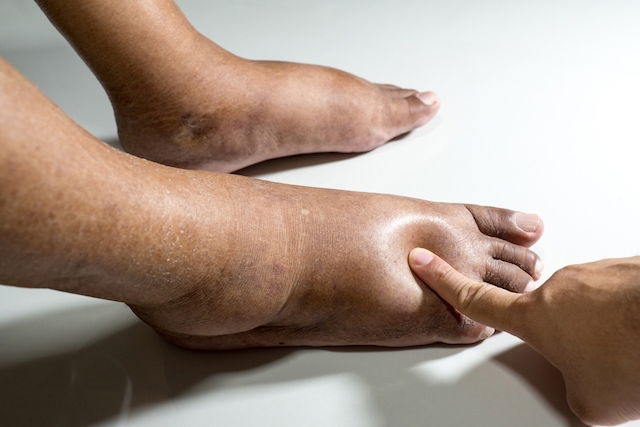Poor circulation in legs is a condition that is generally associated with reduce blood flow in the veins and arteries of the legs. It leads to signs and symptoms like cold feet, swelling, tingling and dry skin.
Poor circulation can happen due to the use of contraceptive pills, being overweight, aging, standing for prolonged periods of time or spending a lot of time sitting with your legs crossed.
It is important that the cause of poor circulation is identified and that any presenting signs and symptoms are discussed with your doctor. This will help him or her to determine the most appropriate treatment approach.

Main symptoms
The main symptoms of poor circulation in the legs are:
- Cold, dry or scaly skin
- Itchy legs
- Red spots on the legs
- Presence of spider veins or varicose veins;
- Swollen feet and ankles
- Pale or bluish color in places with poor circulation
- Leg cramps
- Tingling, stinging or numbness sensation in the legs
- Absence of hair on the legs
- Cracked heels
Symptoms usually worsen at the end of the day, especially after standing for a long time. These symptoms can also become more pronounced during a period, on hot days, or when wearing high heels or flat sandals.
Confirming a diagnosis
The diagnosis of poor circulation in the legs is confirmed by the angiologist or cardiologist. It is initially based on the assessment of the signs and symptoms presented by the patient, as well the patient's clinical and family history. The doctor may also order a Doppler ultrasound to evaluate the blood flow between the arteries and veins, which concludes the diagnosis and the cause of the poor circulation.
Main causes
Poor circulation in the legs is often caused by:
1. Pregnancy
During pregnancy, a woman's body produces more fluids to maintain placental and fetal health. This can put excess force on the veins and make blood flow more difficult. Furthermore, during pregnancy, more relaxin hormones are produced, which causes the veins to dilate, and impedes with optimal blood return to the heart.
2. Atherosclerosis
Atherosclerosis is a condition in which there is a build-up of fatty plaques along the arterial walls. This directly interferes with blood circulation, and makes it more difficult.
3. Excess weight and sedentary lifestyle
Excess weight and a sedentary lifestyle can compromise blood circulation in the body and make venous return more difficult, which can make the legs more swollen and tired.
4. Aging
Aging is a natural cause of poor circulation. As a person ages, there is a loss of elasticity in blood vessels, interfering with optimal circulation.
5. Use of contraceptives
Due to the amount of hormones present in birht control, there may be an increased risk of thrombus formation in some women, which can directly interfere with circulation.
6. Standing for a long time
Standing for prolonged periods or sitting or with your legs crossed can lead to poor circulation in the legs, as these positions physically compromise veins in the legs and impede with normal circulation.
7. Chronic illnesses
Some chronic diseases, like hypertension and diabetes, can result in poor circulation, especially when they are left untreated.
Treatment options
To combat and prevent the symptoms of poor circulation in the legs, it is important to follow treatment as recommended by your doctor. He or she may prescribe the use of compression stockings or medications that act on the veins to improve venous tone, microcirculation and blood vessel resistance.
Taking measures, such as elevating your legs at the end of the day, taking a shower with water at a medium temperature, massaging from the ankle to the groin and wearing comfortable shoes can also help to reduce the discomfort caused by poor circulation.
In addition, regular physical activity and a low-salt diet with lots of vitamin C and antioxidants can also help to avoid and combat the symptoms of poor circulation, as can some home remedies. Check-out a list of natural home remedies to improve circulation.






























